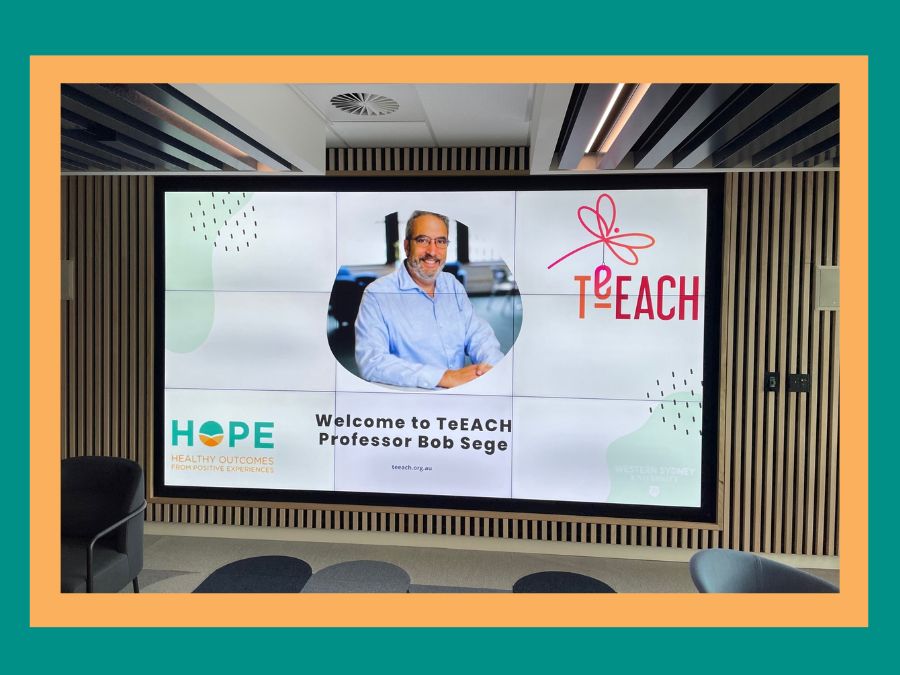
HOPE National Resource Center Director, Bob Sege, went to Darwin Australia at the end of September. Here is part two of his time there. Access part one here.
At the end of September, I was invited to Sydney Australia to celebrate the beginning of a formal partnership with Western Sydney University, which is now the Australasian HOPE network leader. TeEACH (Transforming early Childhood Education and Health) sponsored my visit and distinguished professor Lynn Kemp, Director of the Translational Research and Social Innovation, led the meetings. During the course of the week, we had many opportunities to talk about HOPE and its implementation in Australia.
With the leadership of TeEACH, the HOPE framework has taken hold across Australia. Tuesday afternoon September 27th, we had a working meeting with leaders from Universities and several other child and family serving organizations in Australia. The purpose of the meeting was to discuss collaborations to create a new hub for HOPE activities and research in Australia. Here are a couple of highlights:
Among those attending was Sharon Goldfield, Director of the Center for Community Child Health at the Murdoch Children’s Hospital in Melbourne. Her group has conducted an analysis of the longitudinal survey of Australian children that has validated the use of the Four Building Blocks of HOPE framework in understanding developmental trajectories in Australian children. They are now following up this work with further studies including biomarkers for stress, which may be reduced in children who also have positive experiences.
There was a great deal of discussion regarding the applicability of the HOPE framework in different communities in Australia, including the Aboriginal communities. I was fascinated to hear Shanti Raman, Medical Director for community pediatrics at the Western Sydney Health District about their work in under-resourced communities in Sydney; Professor Rebeka Grace presented insights from ReSPECT, a project built on understanding children’s voices in better understanding how care is understood and received by children.
Professor Lynn Kemp the director of TeEACH, talked about the application of HOPE within their home visiting program (MECSH), seeing a long discussion about embedding HOPE and practices across sectors, and what indicators or measures could be used to assess the effects of adoption of the framework on care.
We spent September 28th together at a meeting about the HOPEful approach to supporting children and families in Australia. Professor Clive Baldock, Dean of Graduate Studies, began the day by announcing the formal partnership between Western Sydney University and Tufts Medical Center in disseminating HOPE. He also let us know that Western Sydney University was just ranked by Times Higher Education as the number one university in the world for social, ecological, and economic impact. It is quite an honor to have them working with us on HOPE.
Following this, we had a delightful day learning about the applications of HOPE in Australia including in education, health, and social services. Meredith O’Connor from Melbourne discussed their work with the longitudinal survey of Australian children, a survey with over 5,000 infants born in 2004 and continuous follow-up since then. The day progressed, with a fascinating session on HOPE in Health, Education, and social services.
Although I love research, perhaps the most moving moment for me was a video link with an aboriginal preschool teacher who described the impact the HOPE framework had on her sense of her work with children in a community with limited resources. Learning about HOPE affirmed her work creating positive childhood experiences for the children in her care. Her young students had an opportunity for relationships with her and each other, the preschool created a safe environment for learning and playing, the children were fully engaged with each other and their staff in group activities, and they experienced emotional growth as they learned to play together. She became a little teary (and so did I), as she described her new understanding of the importance of what she did in preschool – no matter what else was happening in the students’ lives. I spent my last day in Australia with a group of foster care providers who work throughout Australia, organized by Professor Stacy Blythe. They discussed the implications of the HOPE framework in improving the experience of children in care, and their families.
The trip to Australia was transformative. Over the next few years, we expect to see much more coming out of this wonderful collaboration with the extraordinary group TeEACH, their colleagues in Australia, and around the world. Most importantly, I returned home knowing that the HOPE framework has grown far beyond the HOPE National Resource Center and into the lives of children around the globe.


